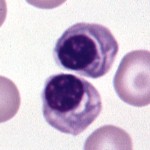 Nucleated erythrocytes in blood in a case of canine plumbism.
The PCV was 39%.
Nucleated erythrocytes in blood in a case of canine plumbism.
The PCV was 39%.
|
The presence of nucleated red cells in peripheral blood (erythroblastosis)
usually signals a regenerative response by marrow to anemia, in which
case it is accompanied by reticulocytosis. In some breeds of dogs, e.g.
Miniature Schnauzers and Dachschunds, small numbers of nucleated red
blood cells may be seen in the circulation of healthy dogs.
Occasionally, they are seen in circumstances of severe endotoxemia,
in which case their presence is a result of injury to marrow causing
"inappropriate" release. They are also seen in cases of acute lead intoxication,
again due to marrow injury.
Circulating nRBCs can also be a feature of myelodysplastic syndromes
and acute myelogenous leukemias, in which cases they are a sign of disturbed
maturation and release of cells from marrow.
The cause in a given case is determined by clinical context, the overall
pattern of the CBC, and the results of other laboratory tests.
Nucleated red blood cells are counted by all hematology analyzers (regardless
of technique) as white blood cells. For this reason, the white blood
cell count must be corrected for the number of nucleated red blood cells
in the circulation. To correct a leukocyte count, the number of NRBCs
per 100 leukocytes is recorded during the differential leukocyte count.
Then a correction is made as follows:
Corrected WBC = nucleated cell count x (100
÷ [nRBC + 100])
In reports from our laboratory, the WBC value with our routine hemograms
is always a leukocyte count since the nucleated cell count is automatically
corrected for NRBCs by our laboratory computer program. |
 Nucleated erythrocytes in blood in a case of canine plumbism.
The PCV was 39%.
Nucleated erythrocytes in blood in a case of canine plumbism.
The PCV was 39%.